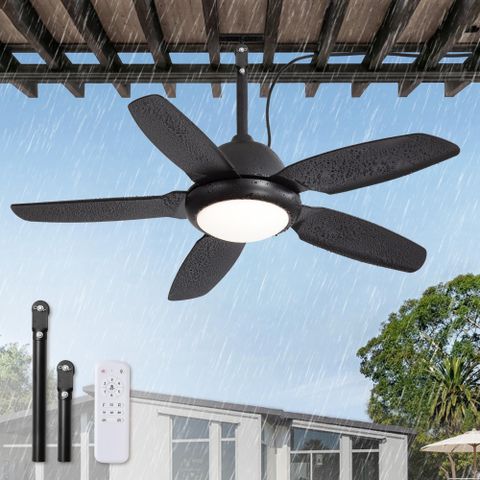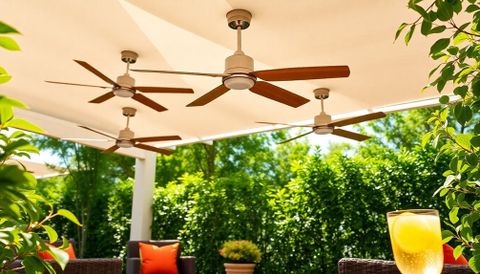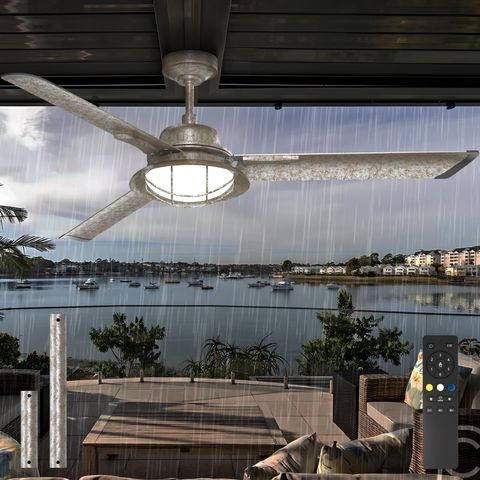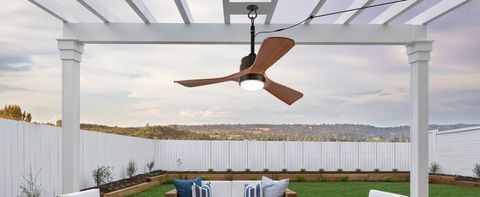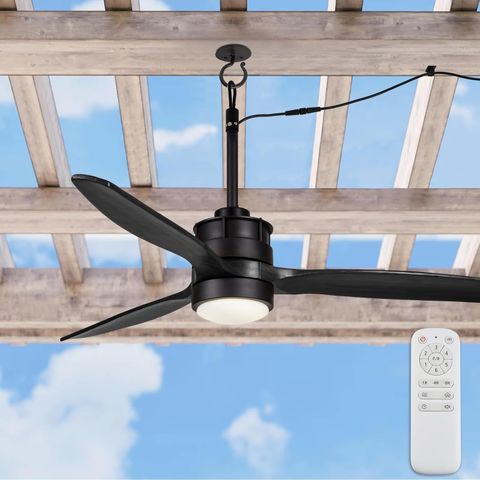Picture this: you’re enjoying a peaceful evening on your patio, the gentle breeze rustling through your favorite chair, when suddenly a gust of wind picks up and rain begins to fall. You realize your outdoor fan isn’t built for such conditions. This scenario is all too common for homeowners who haven’t chosen their outdoor fans wisely. The right outdoor ceiling fan can transform your space from merely functional to truly comfortable, even during the most challenging weather.
Outdoor living spaces have become increasingly popular as people seek to extend their living areas beyond indoor walls. However, these beautiful spaces come with unique challenges, particularly when it comes to weather exposure. From scorching summer heat to unexpected storms, outdoor fans must perform reliably under harsh conditions. Choosing the correct fan isn’t just about aesthetics or airflow—it’s about durability, safety, and long-term satisfaction. Many homeowners make the mistake of purchasing standard indoor fans or overlooking critical specifications. The result? Fans that fail quickly, pose safety risks, or simply don’t deliver the comfort they promise.
Understanding Weather Resistance Ratings
When shopping for outdoor fans, you’ll encounter various weather resistance ratings that indicate how well a fan can handle different environmental conditions. The National Electrical Manufacturers Association (NEMA) provides standards that are crucial to understanding what to look for. A NEMA 3R rating means the fan can handle rain, sleet, snow, and ice. Fans rated NEMA 4X offer additional protection against corrosion and are suitable for marine environments. These ratings aren’t just marketing jargon—they represent real-world testing that ensures performance in challenging conditions. Think of it like choosing hiking boots for different terrains. A pair designed for mountain trails won’t cut it for city streets, just as a fan built for mild climates won’t survive hurricane-force winds. Consider the typical weather patterns in your area, including temperature extremes, humidity levels, and storm frequency. If you live near the coast, marine-grade fans might be essential. For inland areas with intense heat and occasional severe weather, focus on fans with high wind resistance ratings.
Material Selection and Corrosion Protection
The materials used in constructing outdoor fans play a vital role in their longevity and performance. Aluminum components are preferred over steel because they resist rust and corrosion much better. Stainless steel hardware adds an extra layer of protection, especially important for coastal areas where salt air accelerates deterioration. Look for fans with powder-coated finishes that provide both aesthetic appeal and weather protection. These coatings act as barriers against moisture, UV rays, and temperature fluctuations. Some manufacturers use specialized treatments like zinc plating or galvanization to further enhance durability. Real-world experience shows that fans with quality materials last significantly longer than those made with cheaper alternatives. A friend of mine installed a basic outdoor fan three years ago that was already showing signs of rust in just one season. He later upgraded to a premium model with proper corrosion protection and hasn’t had any issues since. The investment in quality materials pays dividends through reduced maintenance and replacement costs.
Motor Quality and Performance Factors
Underneath every outdoor fan lies its motor—a component that works tirelessly to provide comfort. High-quality motors are typically sealed units designed specifically for outdoor use. They feature superior bearings and insulation that prevent moisture damage and ensure consistent operation. Look for motors with permanent split capacitor (PSC) technology, which offers reliable performance and energy efficiency. The motor’s ability to handle varying temperatures and humidity levels directly impacts fan lifespan. Cheaper motors may seem attractive initially, but they often fail within months of installation. Consider the fan’s CFM rating (cubic feet per minute) to ensure adequate airflow for your space. A larger fan blade span generally produces better airflow, but remember that size must match your space dimensions. For example, a 52-inch fan works well for large covered patios, while smaller 44-inch models suit intimate dining areas. Testimonials from users show that fans with robust motors maintain performance even after years of continuous use in demanding conditions.
Blade Design and Aerodynamic Efficiency
Outdoor fan blades must be engineered differently than indoor counterparts to handle weather elements effectively. Blade shape, material, and pitch angle all contribute to performance. Curved or swept-back blades are often more aerodynamically efficient and can handle higher wind speeds. Some fans feature blades with special coatings that repel water and debris. The number of blades also matters—typically two to four blades work best for outdoor applications. Too many blades can create excessive weight and stress on the motor, while too few may not generate sufficient airflow. Consider the blade pitch angle, which affects how much air is moved with each rotation. Higher pitch angles move more air but require more power. A balanced approach considers both efficiency and energy consumption. Many modern outdoor fans incorporate smart design features like blade stiffening to prevent warping in extreme temperatures. Users report significant differences in comfort levels between fans with well-designed blades versus those with basic construction.
Installation Considerations and Mounting Options
Proper installation is crucial for outdoor fan success and safety. Mounting hardware must be specifically designed for outdoor use and capable of handling weather-related stresses. Concrete and brick mounting options provide excellent stability, while wood mounting requires additional weatherproofing measures. Some installations demand professional assistance, particularly when dealing with complex roof structures or electrical requirements. Consider the mounting height—most outdoor fans need at least 10 feet clearance from ground level for safety and optimal airflow. The mounting bracket should be rated for the fan’s weight and wind load capacity. Waterproofing the electrical connections is non-negotiable. Even small gaps can allow moisture intrusion and cause serious problems. Many installation failures stem from inadequate preparation rather than faulty equipment. Professional installers understand local building codes and weather-specific requirements that DIY enthusiasts might overlook. Planning ahead for future maintenance access can save considerable trouble later.
Maintenance and Longevity Tips
Even the best outdoor fans require some care to maintain peak performance. Regular cleaning prevents debris buildup that can affect balance and efficiency. Remove leaves, dirt, and insects periodically using gentle methods that won’t damage delicate components. Check fasteners annually and tighten as needed to prevent loosening from weather expansion and contraction cycles. Lubricate moving parts according to manufacturer recommendations to reduce wear. Most outdoor fans benefit from annual inspection of electrical connections and motor health. Some manufacturers recommend seasonal checks for corrosion signs or blade damage. Keeping a maintenance schedule helps identify potential problems before they become costly repairs. Many users find that simple monthly checks—just wiping down blades and ensuring secure mounting—can extend fan life by several years. Professional servicing every couple of years ensures continued safe operation and optimal performance. Remember that preventive maintenance is far less expensive than emergency repairs or premature replacement.
Choosing the right outdoor ceiling fan for harsh weather conditions requires careful consideration of multiple factors working together. From understanding weather resistance ratings to selecting appropriate materials and ensuring proper installation, each decision impacts long-term satisfaction and safety. The initial investment in a quality outdoor fan pays dividends through years of reliable service, reduced maintenance needs, and enhanced comfort. Don’t let the allure of lower prices or flashy appearances blind you to the fundamental requirements of outdoor performance. Take time to research specifications, read reviews from users in similar climates, and consider consulting with professionals who understand local weather challenges. Your outdoor living space deserves a fan that matches its demands. The right choice transforms discomfort into comfort, turning challenging weather into manageable conditions. With proper selection and care, your outdoor fan will be a trusted companion through countless seasons of enjoyment. Remember, the best fan isn’t always the cheapest—it’s the one that stands up to whatever Mother Nature throws at it.
